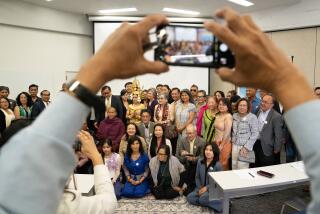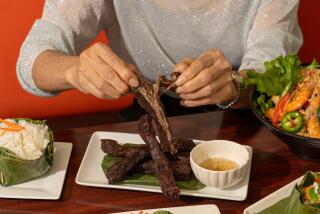At Cocktails in Jakarta, a Chance to Toast Cambodian Peace
- Share via
BANGKOK, THAILAND — It might come as no surprise to hostesses in Bel-Air and Georgetown, but the protocol of throwing a cocktail party in Jakarta is excruciating.
This one is supposed to be an ice-breaker among a small group of antagonistic acquaintances. The Indonesian hosts keep it so casual that diplomats call it simply JIM, for “Jakarta informal meeting.”
But the guests may be a little stiff-necked for canapes and chitchat, and the odds against an embarrassing moment are even at best. After all, these participants have been at war for nearly a decade.
Cocktails in Jakarta on Monday is the first event--”an initial step . . . not yet negotiations,” explains Indonesian Foreign Minister Ali Alatas--in what promises to be a long season of trying to solve the grim conflict in Cambodia.
The guest list includes:
-- Prince Norodom Sihanouk, Cambodian ruler from 1941 to 1970, who says he won’t come, but will send his son, Prince Ranariddh.
-- Hun Sen, premier of the government installed in Phnom Penh by the Vietnamese. Sihanouk calls Hun Sen a Vietnamese lackey, while Hun Sen calls Sihanouk samdech (prince) and says he could make room for him in his government.
-- Khieu Samphan, once a cabinet minister under Sihanouk and later an architect of the brutal back-to-the-fields revolution imposed on Cambodia by the monstrous Pol Pot and his Khmer Rouge regime of 1975-1979.
-- Son Sann, head of the Khmer Peoples National Liberation Front and prime minister of the coalition government for Democratic Kampuchea, a paper alliance that binds opposition guerrillas--his forces, the Khmer Rouge and Sihanouk’s. Sihanouk was president of the Liberation Front until he resigned--again--two weeks ago.
According to the cocktail-party protocol, these men will be first through the door of President Sukarno’s magnificent old palace in Bogor, just outside Jakarta. If the bonhomie survives the first round, representatives of the Assn. of Southeast Asian Nations (ASEAN) will be invited in to raise a diplomatic glass--along with the Vietnamese and their Lao brethren.
For the host, this is the tricky part. Despite their December, 1978, invasion that threw out one Cambodian faction--the Khmer Rouge--and installed another--Hun Sen’s--the Vietnamese guests insist they’re not responsible for the quarrel among Cambodians.
The Vietnamese don’t want to find themselves cornered by an angry band of resistance leaders while Hun Sen stands alone, a diplomatic wallflower. Nor would Hun Sen, a nationalist himself, want his regime’s future being discussed exclusively by its opponents and its founder. Any breach of the protocol, as Hanoi sees it, is likely to lead to a slamming of doors.
And Sihanouk, if he relents and joins the party, could also stage a one-man walkout in princely pique. As the choice of ASEAN and its Western supporters to head a future Cambodian government, Sihanouk sees himself in no other role.
That the party is taking place at all has come as a surprise after nine long years of conflict. Time and circumstances are a factor, along with the persistence of Foreign Minister Alatas and his predecessor, Mochtar Kusumaatmadja.
What has changed? Most scenarios involve the Vietnamese.
“Many Vietnamese officials now virtually concede that 1978-79 (the invasion and occupation) was a mistake,” said a Hanoi-based diplomat recently. “What you have is the appearance of a Vietnamese policy in favor of cutting their losses.”
In Ho Chi Minh City earlier this month, several officials told Western reporters that Vietnamese troops were withdrawing, “having taught our Kampuchean brothers how to grow up,” a consistent line that could mean leaving the Phnom Penh government to stand on its own after 1990, when Hanoi has pledged to remove all its troops.
The pressures for withdrawal are clear. Hanoi has spent billions of dollars of its and its Soviet sponsor’s money on the occupation, and lost 55,000 Vietnamese lives fighting Cambodians over the past 11 years. That’s a high price to pay for marginal benefits.
The invasion established a pro-Hanoi government in Phnom Penh, which along with the pliant regime in Vientiane, Laos, has given the Vietnamese more than nominal sway over the old French-ruled Indochina. That worked well for the mercantile French, but the Vietnamese have merely become the big brother who pays bills and provides troops.
The occupation did smash the tyrannical Khmer Rouge regime and drive its forces out of Vietnam’s southwestern border region; the Cambodian people--and humanity elsewhere--owe the Vietnamese soldier a debt of gratitude for that. But despite its post-invasion propaganda, Hanoi did not strike out of altruism; rather, it had to secure its own border.
In a global sense, the Soviet-financed occupation has put a thorn in the flank of China, just as Beijing’s support of the Khmer Rouge guerrillas has nettled the Kremlin’s clients in Hanoi. But circumstances have changed in the past few years. China and the Soviet Union are making definite steps towards rapprochement. A Cambodian settlement would help cement the process.
A new Communist Party leadership in Hanoi, chosen in December, 1986, has openly conceded that long decades of economic decay and bureaucratic stagnation cannot be reversed without abandoning the harsher Marxist-Leninist tenets. A revolutionary government that came to power on nationalist sentiment risked becoming as unpopular and corrupt as the regimes it replaced.
The problem with cutting losses--if that is what the Vietnamese are doing--is that after nine years nobody on the other side trusts Hanoi. Last month, Deputy Assistant Under Secretary of State David Lambertson told a House subcommittee: “The Vietnamese have announced that they will withdraw 50,000 troops from Cambodia by year end . . . . Based on Hanoi’s previous manipulation of withdrawal dates and announcements, we remain skeptical.”
If Hanoi cannot be trusted, the Khmer Rouge, on the other side of the original coin, cannot be tolerated--by anybody. What if, ask some Western diplomats, the Vietnamese simply walk away from Cambodia--if they “do an Afghanistan?” as one said the other day. Hun Sen asked at a recent press conference in Phnom Penh: “Who is going to be responsible for the Khmer Rouge?”
If the Vietnamese are leaving the field in 1990, it may explain why they are going to Jakarta this week. The only safeguard against the return of the Khmer Rouge, in the absence of a Vietnamese army, is some sort of political solution that provides for a popularly chosen government. After its reign of horror in the late 1970s, the Khmer Rouge has dealt itself out of any popularity contests.
Could Pol Pot’s men still return at the point of a gun? The question is answered by proposals for an international peacekeeping force. But with an estimated 30,000 to 40,000 Khmer Rouge fighters, it might have to be a force larger than that deployed in the Middle East.
The variables are endless in sorting out a solution for Cambodia, but where better to begin solving the world’s problems than at a cocktail party?
More to Read
Sign up for Essential California
The most important California stories and recommendations in your inbox every morning.
You may occasionally receive promotional content from the Los Angeles Times.










